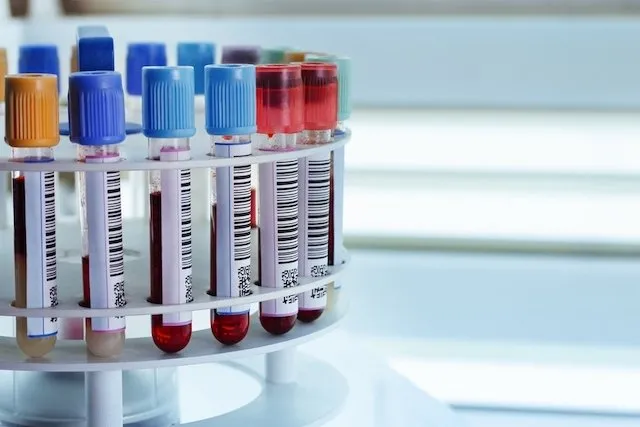To diagnose anemia, it is necessary to take a blood test to assess the amount of red blood cells and hemoglobin, and it is normally indicative of anemia when hemoglobin values are below 12 g/dL in the case of women and 14 g/dL in the case of men. men.
However, hemoglobin concentration is not the only parameter for diagnosing anemia, other tests are normally requested to identify the cause of low hemoglobin and initiate the most appropriate treatment. Learn more about anemia.
Since iron deficiency anemia is the most common, the doctor starts by assessing the amount of ferritin in the blood, as when this substance is in low quantity it means that there is little iron in the body. However, if ferritin values are normal, it may be necessary to carry out further tests such as hemoglobin electrophoresis or counting vitamin B12 and folic acid levels, which help identify other types of anemia.

Main exams
The main tests recommended to confirm anemia are:
1. Blood count
The blood count is the main test performed to diagnose anemia, mainly observing hemoglobin levels. In general, anemia is considered when hemoglobin levels in the blood are:
- In men: less than 14 g/dL of blood;
- In women: less than 12 g/dL of blood;
In addition to evaluating the amount of hemoglobin, the quantity, size and characteristics of the red blood cells are also evaluated in the blood count. Despite being the main test to diagnose anemia, it must be complemented by other blood tests that allow the type of anemia to be identified and, thus, the most appropriate treatment can be initiated. Find out what altered hemoglobin values may indicate.
2. Blood smear
A blood smear is usually taken along with a blood count and aims to evaluate the appearance of blood cells, including red blood cells, under a microscope to determine their size, shape, number, and appearance. In this way, it is possible to assist in the diagnosis of sickle cell anemia, thalassemia, megaloblastic anemia and other hematological changes.
3. Hemoglobin electrophoresis
This test aims to identify the different types of hemoglobin found circulating in the person’s blood, being useful for identifying sickle cell anemia and thalassemia, for example, which is also known as Mediterranean anemia.
It is important that the result of the hemoglobin electrophoresis is evaluated by the doctor and complemented by the results of the blood count and blood smear, the results of other blood tests and the signs and symptoms presented by the person. Learn more about hemoglobin electrophoresis.
4. Reticulocyte count
The reticulocyte count is a type of test that can be requested together with the blood count and aims to identify the presence of reticulocytes in the blood, which are “young red blood cells”. This way, it is possible to assess whether the bone marrow is working correctly, allowing the identification of aplastic anemia. Learn more about reticulocyte count.
5. Iron, ferritin and transferrin
The dosage of iron, ferritin and transferrin are important for the diagnosis of iron deficiency anemia, also known as iron deficiency anemia. These tests are normally requested together with the blood count, since iron deficiency is one of the main causes of decreased hemoglobin concentration and, consequently, anemia.
The transferrin saturation index is a measurement that is calculated based on the levels of iron and transferrin in the blood, and is common to be altered in cases of iron deficiency anemia. Understand better what the transferrin saturation index is.
6. Vitamina B12
The measurement of vitamin B12 in the blood may be requested by the doctor with the aim of investigating pernicious anemia, as a deficiency of this vitamin can lead to anemia. This test is indicated mainly when the blood count shows, in addition to a decrease in hemoglobin, a decrease in the number of red blood cells and a larger size than normal, in addition to changes in the shape of the red blood cells.
7. Bone marrow biopsy
A bone marrow biopsy is an exam that can be performed when changes are found in the blood count and blood smear that suggest that anemia is related to changes in this organ. As it is a more invasive test, bone marrow biopsy is only indicated after other main tests capable of identifying anemia have been carried out.
8. Other exams
Some other tests may be recommended by the doctor to identify the anemia and its type, and investigate the cause, such as:
- Stool examination;
- Bilirubin measurement;
- Measurement of copper levels in the blood;
- Tests to assess liver and kidney function.
It is important that the results of the tests are evaluated by the doctor, as this is the only way to initiate appropriate treatment for the situation. Just having a hemoglobin concentration below the reference value is not enough to determine anemia, and it is very important to carry out additional tests. Learn more about the different types of anemia.
One way to avoid iron deficiency and pernicious anemia, which can arise as a result of diet, is by changing eating habits.

Sign up for our newsletter and stay up to date with exclusive news
that can transform your routine!
Warning: Undefined array key "title" in /home/storelat/public_html/wp-content/plugins/link-whisper-premium/templates/frontend/related-posts.php on line 12
Warning: Undefined array key "title_tag" in /home/storelat/public_html/wp-content/plugins/link-whisper-premium/templates/frontend/related-posts.php on line 13




